The New Loo
When she bought her 80-year-old house in Kansas, Simran Sethi knew the bathroom needed an environmentally minded makeover.
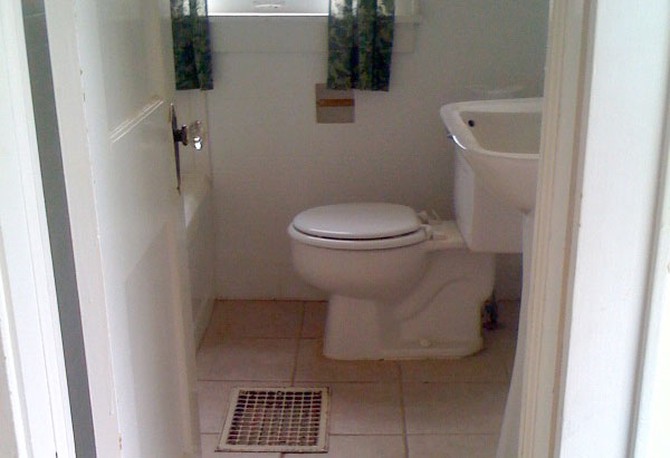
Photo: Jessica Sain-Baird
The Bathroom Before
I'm not going to lie. When it came to purchasing my house, the bathroom was nearly a deal breaker. Eighty percent of my home was perfect—a reflection of the history and love that had been poured into the structure over 80-odd years. But the sole bathroom (and kitchen, which I will address later) had been neglected. The tiles were cracked, the tub was stained and the fixtures and appliances were what one contractor described as the equivalent of cheap beer. I knew that in order for me to feel comfortable in my home, I had to transform the bathroom with champagne upgrades on a table wine budget.
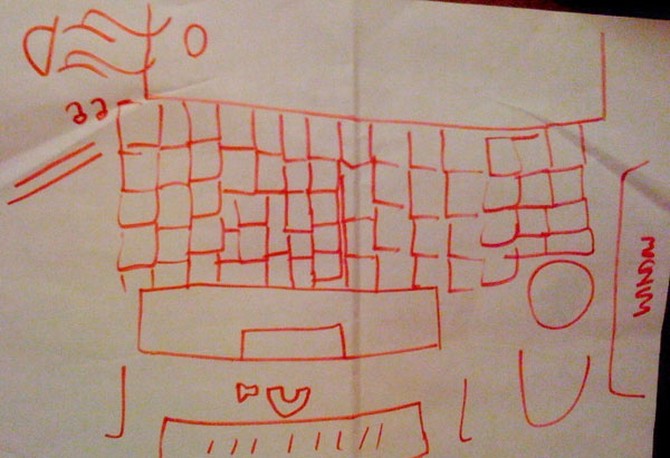
Photo: Jessica Sain-Baird
Simran's Vision
There are a number of reasons a bathroom might be important to you. For me, it's a mash-up of caring about the environment, being vain and having spent much of my adult life in New York. I can live without a functional kitchen and rely on takeout, but a downtrodden bathroom is not acceptable.
My goal was to increase beauty and comfort, maximize space and reduce energy and water consumption. So it will come as no surprise that the second thing I did after closing on the house—right after trying to get rid of brown recluse spiders—was to find a contractor who could help me actualize my vision.
Finding a terrific contractor who was aligned with my vision, understood the kinds of materials I wanted to use and was able to work within a budget and the time frame I needed was not easy. I called everyone whose homes I liked for references and then met with folks and explained what I hoped to achieve. Eventually, we transformed my thoughts into the grubby sketch you see here. I tried to sound confident even when I was not, spending night after night researching every new term a contractor mentioned, and tried to stay optimistic when the contractors I liked said they were not available in my time frame. Just as I was about to give up on the ideal of moving into a house with a nice, new loo, I connected with Ian Hurst.
My goal was to increase beauty and comfort, maximize space and reduce energy and water consumption. So it will come as no surprise that the second thing I did after closing on the house—right after trying to get rid of brown recluse spiders—was to find a contractor who could help me actualize my vision.
Finding a terrific contractor who was aligned with my vision, understood the kinds of materials I wanted to use and was able to work within a budget and the time frame I needed was not easy. I called everyone whose homes I liked for references and then met with folks and explained what I hoped to achieve. Eventually, we transformed my thoughts into the grubby sketch you see here. I tried to sound confident even when I was not, spending night after night researching every new term a contractor mentioned, and tried to stay optimistic when the contractors I liked said they were not available in my time frame. Just as I was about to give up on the ideal of moving into a house with a nice, new loo, I connected with Ian Hurst.
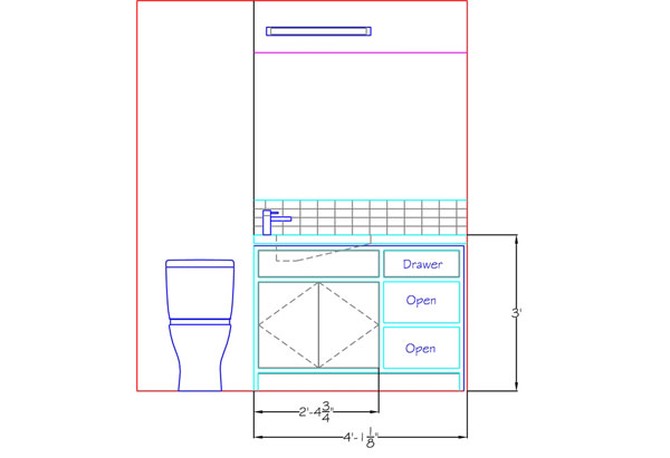
Photo: Jessica Sain-Baird
The Process Begins
Ian was affable, professional and efficient. He understood my commitment to massive energy and water savings while on a modest budget and was also committed to my definition of beauty. This part is important—work with someone who shares, or at least understands, your aesthetic. He or she will make decisions on your behalf whether you plan for it or not, so this shared vision is integral. The best part of our initial meeting was that Ian started taking measurements and drawing immediately. Within days, he had transformed my rough sketch into a workable blueprint.
What the sketch does not show you are the ways that strategically rebuilding a tiny bathroom that is roughly the size of two bathtubs can reduce air pollutants, limit waste, save energy and, in my loo specifically, conserve more than 4,000 gallons of water annually.
The remainder of this post and next week's post are intended to make those invisible decisions visible.
What the sketch does not show you are the ways that strategically rebuilding a tiny bathroom that is roughly the size of two bathtubs can reduce air pollutants, limit waste, save energy and, in my loo specifically, conserve more than 4,000 gallons of water annually.
The remainder of this post and next week's post are intended to make those invisible decisions visible.
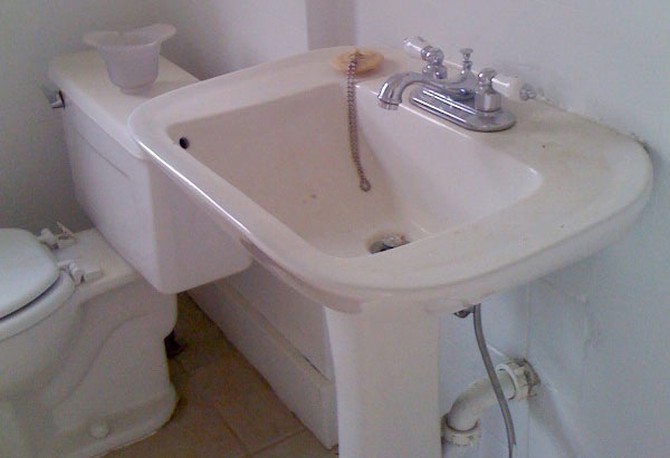
Photo: Jessica Sain-Baird
Choosing What to Change
Before I called a contractor or put pen to paper and sketched out a bathroom plan, I made a prioritized list of what I wanted to change in my bathroom. This served as my touchstone throughout the process. My first goal was to maximize space. That meant I needed to build a small cabinet to accommodate toiletries, thus ensuring I wouldn't have to precariously balance contact lenses, saline, toothpaste and more on the tiny edge of a pedestal sink. Because of my commitment to greening my house, the cabinet needed to be constructed of eco-friendly materials (mine was built from scrap eucalyptus) and finishes.
Recognizing that most of the water we use within our homes is used in the bathroom, my next goal was to conserve water. I made sure my budget could accommodate a water-efficient toilet and low-flow faucet. Additional extensions of resource conservation meant I strove to save energy using radiant heat, efficient lighting and an on-demand hotwater heater; improve air quality with eco-friendly paints and finishes and proper ventilation; and minimize waste by using recycled wood and tiles, saving whatever I could, and donating anything I could not use to my local Habitat for Humanity Restore.
The plan took loads of research, many late nights and an incredible amount of support. And it was all worth it.
Recognizing that most of the water we use within our homes is used in the bathroom, my next goal was to conserve water. I made sure my budget could accommodate a water-efficient toilet and low-flow faucet. Additional extensions of resource conservation meant I strove to save energy using radiant heat, efficient lighting and an on-demand hotwater heater; improve air quality with eco-friendly paints and finishes and proper ventilation; and minimize waste by using recycled wood and tiles, saving whatever I could, and donating anything I could not use to my local Habitat for Humanity Restore.
The plan took loads of research, many late nights and an incredible amount of support. And it was all worth it.
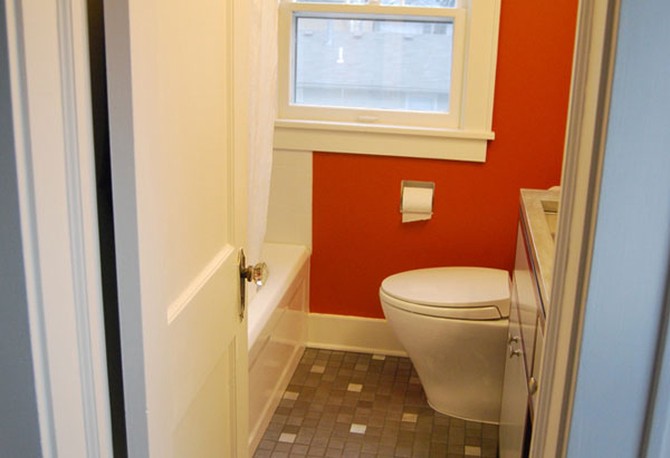
Photo: Jessica Sain-Baird
The Bathroom Now
Though my need for extra storage space may not be a priority for you, one priority should be universal: the need to save water. According to authors Jon Clift and Amanda Cuthbert—who penned the nifty book Water, released by sustainable living publisher Chelsea Green—more than one-fourth of the clean, drinkable water we use in a home is used to flush a toilet. Contrast this with the fact that one in six people on the planet don't have access to enough clean drinking water, and you'll start to understand why we need to reconsider where our water goes.
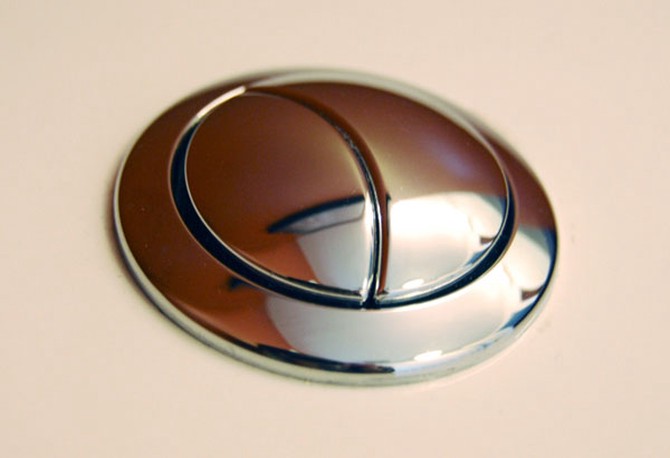
Photo: Jessica Sain-Baird
Transforming Your Toilet
Older toilets and leaky toilets are the biggest water hogs within our homes. An older toilet can use anywhere from 3 to 6 gallons of water with every flush. This is extraordinary in light of the fact that the average person needs about 13 gallons of water a day to drink, wash and eat, according to Tom Kostigen's The Green Blue Book.
The two changes you can make right now are to displace the amount of water in your toilet tank and check for leaks. First, fill up a plastic juice or milk jug with pebbles or sand, screw the lid back on, and place it in the back of the tank clear of any flush mechanisms. A commercial toilet tank bank will also do the trick. Just make sure you have at least 3 gallons of water left in your toilet tank for proper flushing. Now, check for drips. If you aren't sure if your toilet is leaking, put a few drops of food coloring in the tank and see if it ends up in the bowl. Leaks can waste up to 20 gallons of water per day. It's worth springing for a plumber if you can't fix the leak yourself.
If you have the means to replace your toilet now, investigate low-flow and dual-flush options. A low-flow toilet uses 1.6 gallons per flush. A dual-flush toilet uses different amounts of water depending on what you're putting in the bowl—less than a gallon of water to process liquids, more to process solids. I was intrigued by the dual-flush settings and spent uncountable hours researching flush rates, flow rates and waste disposal. The company that got consistently high marks for efficiency and efficacy was Toto. I went with their dual-flush Aquia III and am a mighty happy (and water-efficient) gal. One note: There is less water in the bowl. Since stuff can stick to the sides of the toilet, I spend a little more time keeping my toilet clean than I used to with my old water-hogging toilet. Bu it really isn't a big deal. I contacted Toto and was told their low-flow toilets have a more powerful flush than the dual-flush varieties, so am going to try one of those out when I convert my downstairs closet into a half-bath.
The two changes you can make right now are to displace the amount of water in your toilet tank and check for leaks. First, fill up a plastic juice or milk jug with pebbles or sand, screw the lid back on, and place it in the back of the tank clear of any flush mechanisms. A commercial toilet tank bank will also do the trick. Just make sure you have at least 3 gallons of water left in your toilet tank for proper flushing. Now, check for drips. If you aren't sure if your toilet is leaking, put a few drops of food coloring in the tank and see if it ends up in the bowl. Leaks can waste up to 20 gallons of water per day. It's worth springing for a plumber if you can't fix the leak yourself.
If you have the means to replace your toilet now, investigate low-flow and dual-flush options. A low-flow toilet uses 1.6 gallons per flush. A dual-flush toilet uses different amounts of water depending on what you're putting in the bowl—less than a gallon of water to process liquids, more to process solids. I was intrigued by the dual-flush settings and spent uncountable hours researching flush rates, flow rates and waste disposal. The company that got consistently high marks for efficiency and efficacy was Toto. I went with their dual-flush Aquia III and am a mighty happy (and water-efficient) gal. One note: There is less water in the bowl. Since stuff can stick to the sides of the toilet, I spend a little more time keeping my toilet clean than I used to with my old water-hogging toilet. Bu it really isn't a big deal. I contacted Toto and was told their low-flow toilets have a more powerful flush than the dual-flush varieties, so am going to try one of those out when I convert my downstairs closet into a half-bath.
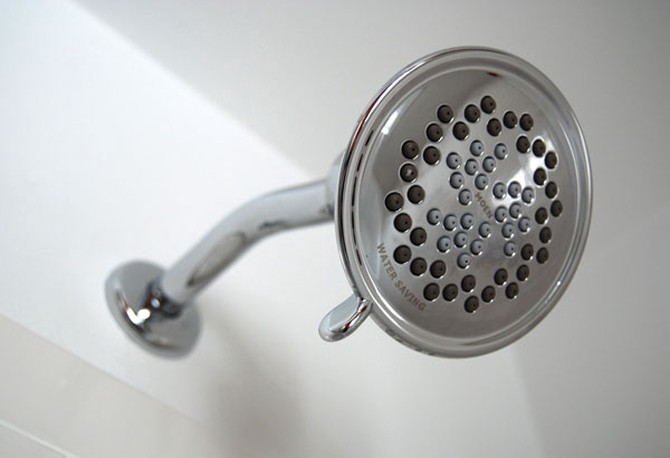
Photo: Jessica Sain-Baird
Sustainable Showering
The second time I was on The Oprah Winfrey Show, Ms. Winfrey said she was game for recycling, up for swapping out light bulbs, even willing to try out new household cleaners—but refused to give up her delightful, strong shower. I completely understood.
Low-flow showerheads of yesteryear had the spray of a weak sprinkler and seemed to defeat the purpose of saving water because it took so long to actually collect enough water to get clean. Things are different now. Low-flow showerheads can reduce water consumption by up to 50 percent without giving up needed pressure (psi). I have tried a few low-flow showerheads in my life, and while many that fell into that "sprinkler" category, the good ones didn't. My favorite is Moen's Envi showerhead. The flow feels strong and I don't feel like I am missing anything.
What is also important to me is the bigger context of the product and how it's made. Moen recycles more than 90 percent of the materials used in manufacturing, and they are working to create a culture of sustainability within the company, filtering all water so employees are reusing the majority of water used in product testing, ensuring all new products use less water and meet EPA WaterSense guidelines and aren't consuming bottled water.
Low-flow showerheads of yesteryear had the spray of a weak sprinkler and seemed to defeat the purpose of saving water because it took so long to actually collect enough water to get clean. Things are different now. Low-flow showerheads can reduce water consumption by up to 50 percent without giving up needed pressure (psi). I have tried a few low-flow showerheads in my life, and while many that fell into that "sprinkler" category, the good ones didn't. My favorite is Moen's Envi showerhead. The flow feels strong and I don't feel like I am missing anything.
What is also important to me is the bigger context of the product and how it's made. Moen recycles more than 90 percent of the materials used in manufacturing, and they are working to create a culture of sustainability within the company, filtering all water so employees are reusing the majority of water used in product testing, ensuring all new products use less water and meet EPA WaterSense guidelines and aren't consuming bottled water.
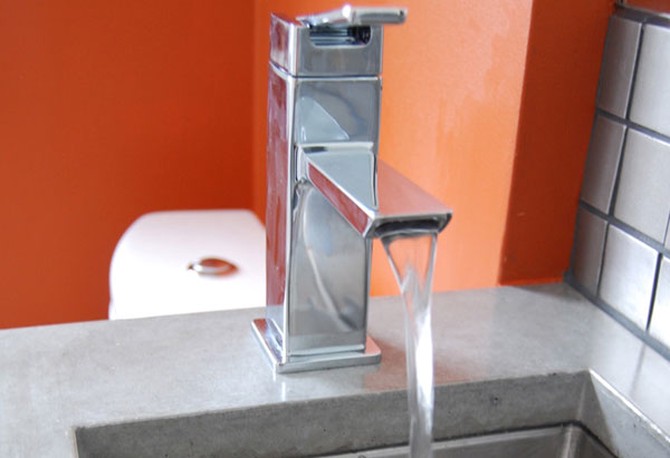
Photo: Jessica Sain-Baird
Being Conscious About Water Faucets—Turn Off the Tap
Water faucets are another smart place to conserve water. First of all, turn off the water when you don't need it. It's that simple. I don't want to sound too preachy, but, according to UNICEF and the World Health Organization, lack of access to clean drinking water kills about 4,500 children per day. The water won't magically travel from our taps to someone in need, but creating a mind-set of conservation will certainly help. There is absolutely no purpose served by letting water you are not using run down the drain.
As for the water you are using, install low-flow aerators in your faucets. They cost less than a dollar, are so easy to install even I can do it and can reduce your water consumption by up to 50 percent. Also look for ready-made faucets that have maximum flow rates that are 30 percent lower than standard models. Mine's a Moen.
As for the water you are using, install low-flow aerators in your faucets. They cost less than a dollar, are so easy to install even I can do it and can reduce your water consumption by up to 50 percent. Also look for ready-made faucets that have maximum flow rates that are 30 percent lower than standard models. Mine's a Moen.
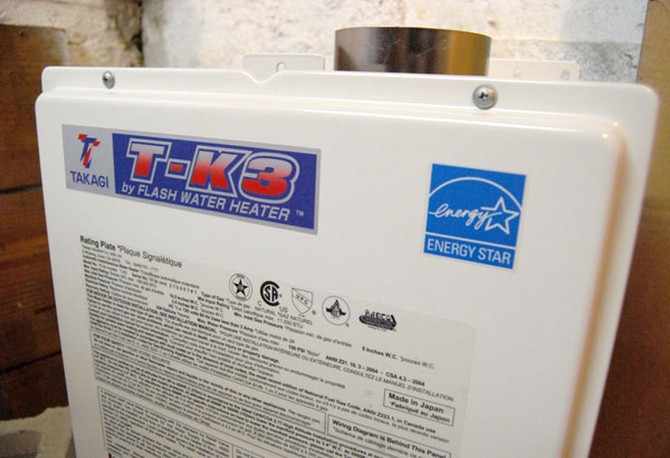
Photo: Jessica Sain-Baird
Heating Water in Your Home
According to Jon Clift and Amanda Cuthbert's Water, installing a water-efficient toilet, using a low-flow tap and using a low-flow showerhead can reduce your overall water consumption by about 25 percent. Reducing the amount of water you use in the bathroom will not only help drop your utility costs, it will also show up in lower electricity bills.
The Department of Energy says heating water is the third-most energy-consuming activity within our homes. As I detailed in my energy post, using less water overall results in heating less water, thus saving more energy. By insulating your hot water heater with these step-by-step instructions and lowering its thermostat to 120 degrees, you will improve your energy efficiency without effecting your morning shower.
Another great option that will reap you a federal tax credit for consumer energy efficiency for 30 percent of costs up to $1,500 is a tankless, or on-demand, hot water heater. The heater is tiny and warms water only when needed rather than storing it in a massive tank. One of my favorite resources during this green home process has been Green Building Supply in Fairfield, Iowa. They were my starting point for research on tankless hot water heaters and recommended a Takagi. This advice was echoed by my plumber and through high-performance scores by Consumer Reports. Takagi has been making these products since well before green was the latest trend, and they were the first company to introduce tankless hot water heaters to North America. Their products are made from 95 percent recycled materials and are 35 to 50 percent more efficient than a conventional hot water tank. Like Moen, they are committed to a culture of sustainability, making sure that going green isn't just a tip or a tagline, but a way of looking at the world and using resources differently.
Now take a look at the rest of the loo!
Simran
Simran Sethi is an award-winning journalist and associate professor at the University of Kansas School of Journalism and Mass Communications. For more information on Sethi, visit SimranSethi.com and follow her on Twitter @simransethi.
The Department of Energy says heating water is the third-most energy-consuming activity within our homes. As I detailed in my energy post, using less water overall results in heating less water, thus saving more energy. By insulating your hot water heater with these step-by-step instructions and lowering its thermostat to 120 degrees, you will improve your energy efficiency without effecting your morning shower.
Another great option that will reap you a federal tax credit for consumer energy efficiency for 30 percent of costs up to $1,500 is a tankless, or on-demand, hot water heater. The heater is tiny and warms water only when needed rather than storing it in a massive tank. One of my favorite resources during this green home process has been Green Building Supply in Fairfield, Iowa. They were my starting point for research on tankless hot water heaters and recommended a Takagi. This advice was echoed by my plumber and through high-performance scores by Consumer Reports. Takagi has been making these products since well before green was the latest trend, and they were the first company to introduce tankless hot water heaters to North America. Their products are made from 95 percent recycled materials and are 35 to 50 percent more efficient than a conventional hot water tank. Like Moen, they are committed to a culture of sustainability, making sure that going green isn't just a tip or a tagline, but a way of looking at the world and using resources differently.
Now take a look at the rest of the loo!
Simran
Simran Sethi is an award-winning journalist and associate professor at the University of Kansas School of Journalism and Mass Communications. For more information on Sethi, visit SimranSethi.com and follow her on Twitter @simransethi.
Published 03/09/2010

